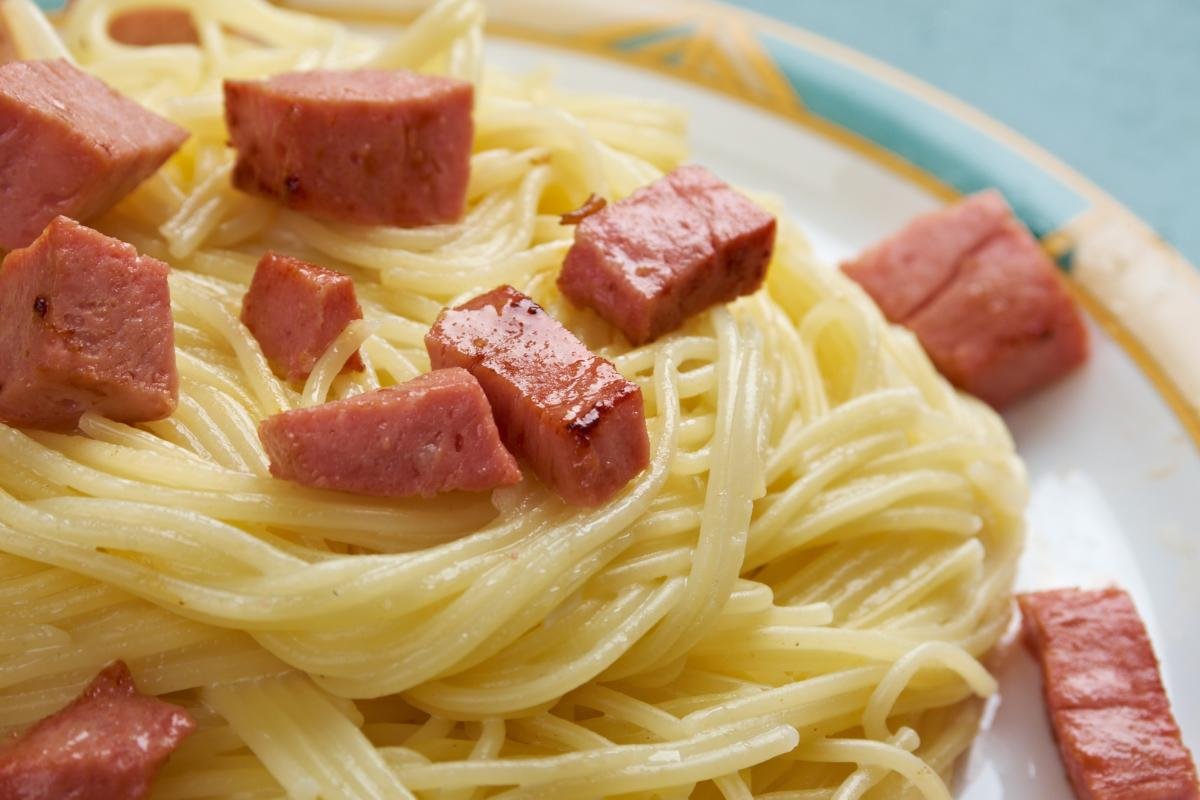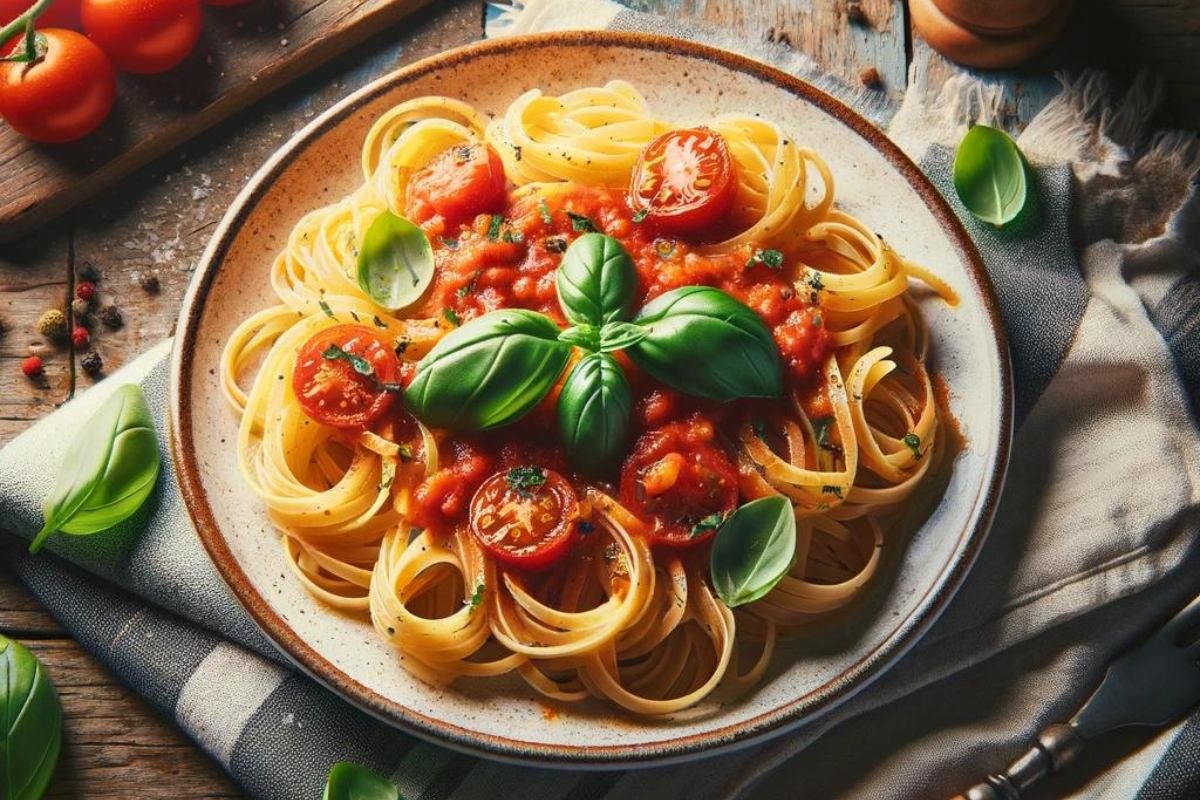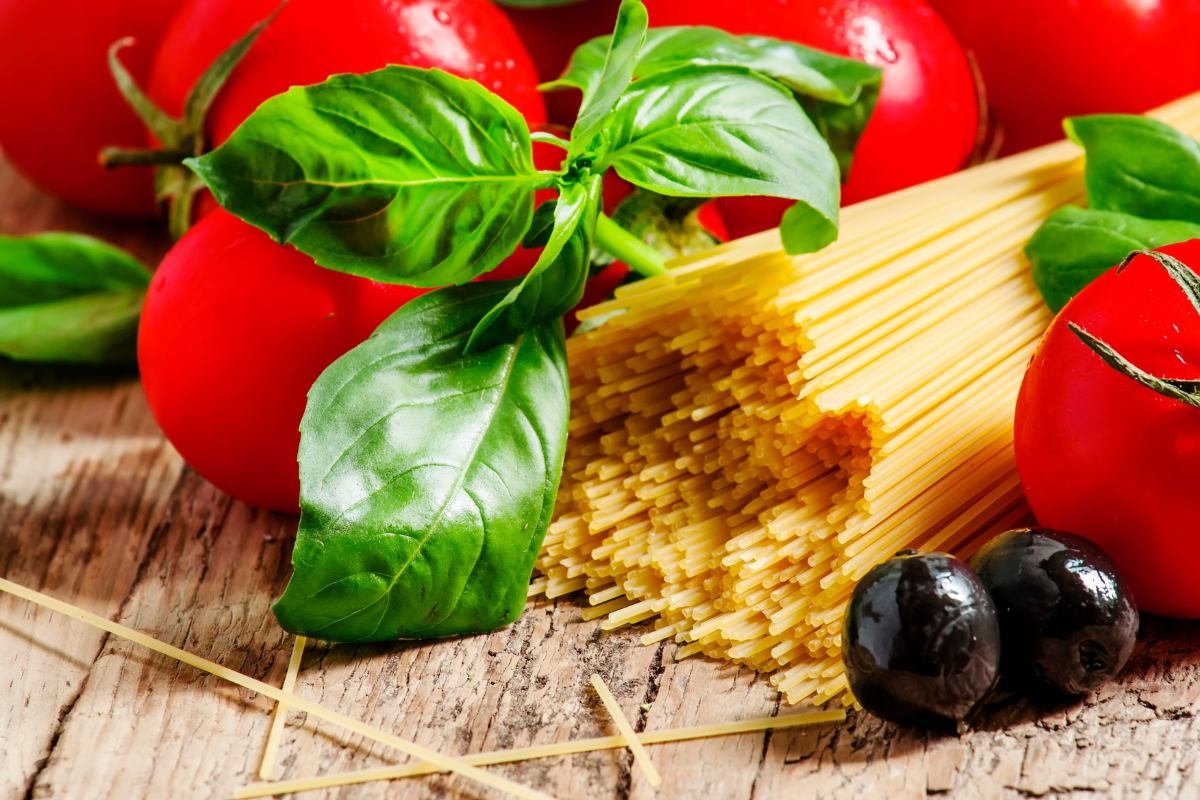Introduction to Capellini
Capellini, often known as “angel hair pasta,” is a staple of Italian cuisine that embodies simplicity and elegance. This very thin variety of pasta, whose name literally translates to “little hairs,” has roots deeply entrenched in Italian culinary traditions. Originating from the beautiful regions of Italy, capellini has traveled the world, becoming a beloved ingredient in countless dishes.
The charm of capellini lies in its delicate texture, which allows it to cook rapidly, making it a favorite for quick and light meals. Despite its thinness, capellini holds onto sauces wonderfully, serving as a perfect canvas for a myriad of flavors ranging from the hearty and robust to the light and aromatic.
In Italian families, capellini is often reserved for special occasions, reflecting the finesse and care in its preparation and presentation. It’s not just a pasta; it’s a celebration of Italian culture, embodying the country’s passion for fine, lovingly prepared cuisine.
Understanding capellini requires more than just knowledge of its preparation; it involves an appreciation of its place within Italian heritage and its evolution into a global culinary icon. In this blog, we’ll explore the intricacies of cooking capellini, delve into classic and modern recipes, and uncover the secrets behind pairing it with the perfect wine. We’ll also shed light on its nutritional benefits and its place in cuisines around the world, demonstrating capellini’s versatility and enduring appeal.
The Art of Cooking Capellini
Cooking capellini, or angel hair pasta, to perfection is an art that balances delicacy with precision. This section walks you through the essential techniques for preparing capellini, ensuring it turns out perfectly every time. We’ll cover everything from boiling the pasta to pairing it with sauces and providing serving suggestions.
Selecting Your Capellini
Start by choosing high-quality capellini. Opt for brands that use 100% durum wheat semolina, as this will ensure your pasta has the ideal texture and flavor.
Boiling Capellini
- Water to Pasta Ratio: Use a large pot, allowing at least 4 quarts of water for every 8 ounces of capellini. This gives the pasta ample space to move and cook evenly.
- Salting the Water: Generously salt the boiling water. A good rule of thumb is about 1 tablespoon of salt for every 2 quarts of water. This is crucial for flavoring the pasta from the inside out.
- Cooking Time: Keep a vigilant eye on the clock. Capellini cooks much quicker than thicker pasta varieties, usually in about 2 to 4 minutes. Start tasting the pasta after two minutes to ensure it reaches your desired level of al dente.
- Stirring: Stir occasionally to prevent the strands from sticking together. Use a wooden spoon or fork for gentle yet effective stirring.
Draining and Rinsing
Once your capellini is al dente, drain it immediately. Unlike thicker pastas, you should not rinse capellini after draining, except when you’re using it in a cold pasta salad. Rinsing can remove the pasta’s natural starches that help sauces cling to it.
Sauce Pairing
Capellini’s delicate texture pairs best with equally light and simple sauces. Here are a few guidelines:
- Olive Oil-Based: A classic aglio e olio, made with garlic, olive oil, and chili flakes, complements capellini without overpowering it.
- Tomato-Based: Opt for fresh, lightly cooked tomato sauces. Their acidity and brightness enhance the pasta without weighing it down.
- Herb-Infused: Fresh herbs like basil, parsley, or chives add a burst of flavor without the need for heavy sauces.
Serving Suggestions
To serve capellini, consider the following tips to elevate your dish:
- Prevent Sticking: If you’re not immediately adding sauce, toss the pasta with a bit of olive oil. This keeps the strands from sticking together.
- Temperature: Capellini is best served immediately after cooking. Its thin strands cool quickly, so pair it with warm sauce and serve it hot.
- Portioning: Use a serving fork or tongs to twirl and plate the pasta. This method creates an appealing mound that holds sauce well.
Mastering capellini requires a blend of careful timing, proper technique, and a sense of balance in flavor pairing. By following these guidelines, you can ensure that your capellini dishes are light, flavorful, and perfectly cooked. Whether dressed in a simple sauce or used as a base for more elaborate creations, capellini offers a delicate canvas that beautifully showcases the ingredients it’s paired with.
Classic Capellini Recipes

In this section, we dive into the heart of capellini’s charm by exploring two timeless recipes that have delighted palates for generations. These classic dishes highlight the versatility and delicate nature of capellini, offering a taste of Italy’s rich culinary tradition.
Capellini al Pomodoro (Capellini with Tomato Sauce)
Capellini al Pomodoro is a quintessential Italian dish, celebrated for its simplicity and the way it allows the natural flavors of its ingredients to shine through.
Ingredients:
- 400 grams of capellini pasta
- 2 tablespoons of extra virgin olive oil
- 3 cloves of garlic, minced
- 400 grams of ripe cherry tomatoes, halved
- A handful of fresh basil leaves, torn
- Salt and pepper to taste
- Grated Parmigiano-Reggiano cheese, for serving
Instructions:
- Prepare the Tomato Sauce: Heat the olive oil in a large skillet over medium heat. Add the minced garlic and sauté until fragrant, about 1 minute. Add the halved cherry tomatoes and cook until they begin to break down and form a sauce, approximately 8-10 minutes. Season with salt and pepper to taste. Stir in the torn basil leaves just before removing from heat.
- Cook the Capellini: While the sauce simmers, bring a large pot of salted water to a boil. Add the capellini and cook according to the package instructions, usually 2 to 3 minutes, until al dente. Drain the pasta, reserving a cup of the pasta water.
- Combine and Serve: Toss the cooked capellini into the skillet with the tomato sauce. If the sauce is too thick, add a little reserved pasta water to achieve your desired consistency. Serve immediately, garnished with grated Parmigiano-Reggiano cheese and additional basil leaves.
Capellini Aglio e Olio (Capellini with Garlic and Oil)
A dish that stands as a testament to the philosophy that less is more, Capellini Aglio e Olio is marvelously simple yet bursting with flavor.
Ingredients:
- 400 grams of capellini pasta
- 5 tablespoons of extra virgin olive oil
- 4 cloves of garlic, thinly sliced
- 1 teaspoon of red pepper flakes (adjust to taste)
- Salt to taste
- A handful of fresh parsley, chopped
- Grated Parmigiano-Reggiano cheese, for serving
Instructions:
- Infuse the Oil: In a large skillet, heat the olive oil over medium heat. Add the sliced garlic and red pepper flakes, cooking until the garlic is golden and fragrant. Be careful not to let the garlic burn.
- Cook the Capellini: Bring a large pot of salted water to a boil. Add the capellini and cook until al dente, about 2 to 3 minutes. Drain, reserving a cup of the pasta water.
- Toss and Serve: Add the drained capellini to the skillet with the infused oil. Toss well to coat the pasta in the garlic and oil. If the pasta seems dry, add a bit of the reserved pasta water. Season with salt to taste. Serve immediately, garnished with chopped parsley and grated Parmigiano-Reggiano cheese.
Both of these recipes celebrate the delicate texture and quick cooking time of capellini, pairing it with light, flavorful sauces that enhance rather than overpower the pasta. Whether you prefer the fresh, tangy taste of tomatoes or the bold simplicity of garlic and oil, these classic capellini dishes offer a delicious glimpse into the heart of Italian cuisine.
Modern Twists on Capellini
As we journey through the evolution of capellini, we encounter the creative landscape of modern cuisine, where this traditional pasta takes on new, innovative roles. Here, we explore two modern twists on capellini that fuse classic elements with contemporary flavors and techniques, showcasing the pasta’s versatility.
Capellini with Avocado Pesto and Cherry Tomatoes
This recipe introduces a creamy, rich twist to the traditional pesto, incorporating avocado for a modern touch. The result is a vibrant, nutrient-packed dish that’s as pleasing to the palate as it is to the eye.
Ingredients:
- 400 grams of capellini pasta
- 2 ripe avocados, pitted and scooped
- 1 cup of fresh basil leaves
- 2 cloves of garlic
- 2 tablespoons of lemon juice
- 1/3 cup of extra virgin olive oil
- Salt and pepper to taste
- 1 cup of cherry tomatoes, halved
- Grated Parmigiano-Reggiano cheese, for serving
Instructions:
- Make the Avocado Pesto: In a food processor, combine the avocados, basil leaves, garlic, and lemon juice. Pulse until smooth. With the processor running, gradually add the olive oil until the mixture is creamy. Season with salt and pepper to taste.
- Cook the Capellini: Bring a large pot of salted water to a boil. Add the capellini and cook until al dente, about 2 to 3 minutes. Drain, reserving a cup of the pasta water.
- Combine and Serve: Toss the cooked capellini with the avocado pesto, adding a bit of reserved pasta water if needed to achieve a smooth consistency. Stir in the halved cherry tomatoes. Serve immediately, garnished with grated Parmigiano-Reggiano cheese.
Spicy Capellini with Shrimp and Lime
This dish infuses capellini with the zest and heat of lime and chili, complemented by the succulence of shrimp. It’s a perfect example of how capellini can be adapted to suit a range of global flavors.
Ingredients:
- 400 grams of capellini pasta
- 2 tablespoons of olive oil
- 400 grams of shrimp, peeled and deveined
- 2 cloves of garlic, minced
- 1 teaspoon of red chili flakes (adjust to taste)
- Zest and juice of 1 lime
- Salt to taste
- A handful of fresh cilantro, chopped
- Lime wedges, for serving
Instructions:
- Sauté the Shrimp: Heat the olive oil in a large skillet over medium-high heat. Add the shrimp, garlic, and chili flakes. Cook until the shrimp are pink and opaque, about 2 to 3 minutes per side. Stir in the lime zest and juice, and season with salt.
- Cook the Capellini: Meanwhile, bring a large pot of salted water to a boil. Add the capellini and cook until al dente, about 2 to 3 minutes. Drain.
- Toss and Serve: Add the cooked capellini to the skillet with the shrimp. Toss to combine, ensuring the pasta is evenly coated with the sauce. Serve immediately, garnished with chopped cilantro and lime wedges.
These modern capellini recipes not only demonstrate the pasta’s flexibility in pairing with a wide range of ingredients but also its ability to bridge traditional and contemporary culinary worlds. By embracing bold flavors and innovative combinations, these dishes invite us to explore new horizons while honoring the essence of capellini.
Pairing Wines with Capellini Dishes
Choosing the perfect wine to complement a capellini dish elevates the dining experience, harmonizing flavors and enhancing the overall meal. In this section, we’ll explore wine pairings for different types of capellini dishes, focusing on matching the wine’s body, acidity, and flavor profile with the ingredients and sauces used in capellini recipes.
Light and Fresh Capellini Dishes
Capellini al Limone or with Light Seafood Sauces
For capellini served with lemon-based sauces or light seafood preparations, opt for wines that mirror the dish’s brightness and acidity. A crisp, mineral-forward white wine such as Vermentino or Pinot Grigio complements the zesty lemon and delicate seafood flavors, enhancing the freshness of the dish without overwhelming it.
Recommended Wines:
- Vermentino: Offers citrus and herbal notes that echo the zestiness of lemon-based sauces.
- Pinot Grigio: Its light body and crisp finish pair well with the delicacy of capellini and seafood.
Tomato-Based Capellini Dishes
Capellini al Pomodoro or with Rich Tomato Sauces
Tomato-based capellini dishes call for wines with enough acidity to match the tomatoes’ tanginess and a fruit-forward profile to balance the sauce’s richness. A medium-bodied Chianti or a vibrant Sangiovese are excellent choices, as their red fruit notes and acidity complement the tomato sauce, creating a harmonious blend of flavors.
Recommended Wines:
- Chianti: Known for its bright acidity and cherry flavors, it pairs wonderfully with tomato-based sauces.
- Sangiovese: Its high acidity and berry notes offer a perfect counterbalance to the sweetness and acidity of tomatoes.
Garlic and Oil-Based Capellini Dishes
Capellini Aglio e Olio or with Spicy Arrabbiata
For capellini tossed in garlic, oil, and sometimes chili flakes, select a wine that can stand up to the bold flavors without overshadowing the pasta’s simplicity. A Soave or a light-bodied Barbera works well, offering a balance of acidity and subtle fruitiness that complements the garlic’s punch and the heat from the chili.
Recommended Wines:
- Soave: Its subtle floral and almond notes bring out the complexity of garlic and oil without competing with the dish’s flavors.
- Barbera: The wine’s bright acidity and low tannins make it versatile enough to pair with both the richness of olive oil and the spice of chili flakes.
Rich and Creamy Capellini Dishes
Capellini with Creamy Sauces or Luxurious Truffle Oil
For richer capellini dishes featuring cream-based sauces or truffle oil, choose a wine with enough body and complexity to match the dish’s depth. A full-bodied Chardonnay or a Viognier with its aromatic profile can complement the creaminess of the sauce, adding layers of flavor without overwhelming the pasta.
Recommended Wines:
- Chardonnay: With its buttery notes and full body, it pairs well with creamy sauces, echoing the richness of the dish.
- Viognier: The wine’s floral aromatics and silky texture match well with the luxurious feel of truffle oil and cream.
Final Thoughts
Pairing wine with capellini is an art that enhances the dining experience, creating a symphony of flavors that delight the palate. By selecting wines that complement the primary flavors and textures of capellini dishes, you can turn a simple meal into an unforgettable culinary adventure. Whether you’re enjoying a light and zesty capellini al limone or indulging in a rich and creamy truffle-infused pasta, there’s a perfect wine out there to elevate your dish to new heights.
Nutritional Benefits of Thin Spaghetti
Thin spaghetti, with its delicate strands and versatile nature, is more than just a culinary delight. This section delves into the healthful aspects of thin spaghetti, uncovering its nutritional content and how it fits into a balanced diet. Understanding the benefits can help you make informed choices about incorporating thin spaghetti into your meals, ensuring that you enjoy not just the flavors but also the advantages it offers to your health.
Low in Fat and Calories
Thin spaghetti stands out as a low-fat option for those monitoring their calorie intake. A serving of this pasta provides a satisfying base for a variety of dishes without contributing significantly to daily fat and calorie totals. This characteristic makes it an excellent choice for individuals aiming to maintain or reduce weight while still enjoying delicious and fulfilling meals.
Active Tip: Pair thin spaghetti with tomato-based sauces or a light drizzle of olive oil and herbs to keep your meal lean and nutritious.
A Source of Complex Carbohydrates
Pasta, including thin spaghetti, is a rich source of complex carbohydrates, essential for providing the body with energy. Unlike simple sugars, complex carbohydrates break down slowly, offering sustained energy release and keeping hunger at bay for longer periods. This makes thin spaghetti an excellent option for athletes or anyone needing a boost in stamina and performance throughout the day.
Active Tip: Opt for whole wheat thin spaghetti to increase your intake of dietary fiber, which aids in digestion and contributes to heart health.
Contains Essential Nutrients
Thin spaghetti is fortified with various vitamins and minerals, such as B vitamins, iron, and magnesium. These nutrients play vital roles in body functions, including supporting metabolic processes, oxygen transport, and muscle and nerve function.
Active Tip: Complement dishes made with thin spaghetti with vegetables and lean proteins to create a balanced meal rich in essential nutrients.
Dietary Flexibility
For those with dietary restrictions or preferences, thin spaghetti offers flexibility. Available in whole wheat, gluten-free, and even high-protein varieties, there’s an option to suit almost any dietary need. This adaptability ensures that everyone can enjoy the benefits and flavors of thin spaghetti, regardless of specific health concerns or dietary choices.
Active Tip: Explore different types of thin spaghetti to find the one that best fits your nutritional goals and dietary requirements.
Incorporating Thin Spaghetti into a Healthy Diet
Embracing thin spaghetti in your diet allows for culinary creativity without sacrificing nutritional value. By pairing it with a mix of vegetables, lean proteins, and healthy fats, you can create balanced meals that nourish the body and delight the palate. Remember, moderation is key; enjoy thin spaghetti as part of a varied diet to reap the most health benefits.
Capellini in Global Cuisines
Capellini, a pasta celebrated for its delicate texture and swift cooking time, has found its way into dishes across the globe. This section reveals how angel hair pasta seamlessly integrates into various culinary traditions, adopting local flavors while maintaining its unique appeal. From the East to the West, this versatile pasta demonstrates its universal allure, proving that great food knows no boundaries.
Angel Hair Pasta’s Asian Fusion
In the realm of Asian fusion cuisine, angel hair pasta discovers new expressions. Chefs innovatively swap traditional noodles with angel hair, infusing them with bold Asian flavors. This approach highlights the pasta’s ability to meld with the intense tastes of soy sauce, sesame oil, and fresh herbs, offering a fresh pasta experience that delights the senses.
Active Tip: Experiment with angel hair pasta in your favorite Asian recipes for an unexpected twist on traditional noodle dishes.
Mediterranean Inspirations
The Mediterranean diet, praised for its health benefits and emphasis on fresh ingredients, also welcomes angel hair pasta. Here, it’s often paired with seafood, fresh vegetables, and a touch of olive oil, embodying the simplicity and wholesomeness of Mediterranean cooking. This combination not only showcases the pasta’s adaptability but also its capability to harmonize with the vibrant flavors of the region.
Active Tip: Craft a Mediterranean-inspired dish using angel hair pasta with grilled seafood, cherry tomatoes, olives, and a splash of lemon for a nutritious yet satisfying meal.
Latin American Twists
Taking a colorful journey through Latin American cuisine, angel hair pasta is incorporated into robust and flavorful dishes. A creative twist is its use in traditional soups and broths, where it soaks up the rich flavors of the stock and spices, adding a delightful texture to each bite. This innovative use underscores the pasta’s ability to complement and enhance the bold tastes of Latin American cooking.
Active Tip: Add angel hair pasta to your next homemade chicken or vegetable soup for an intriguing texture and added depth.
Fusion Cuisine Adventures
The fusion cuisine movement, with its core of culinary creativity and integration, has warmly embraced angel hair pasta. Global chefs are crafting dishes that blend ingredients and techniques from diverse traditions, with angel hair pasta often playing a pivotal role. Whether combined with ingredients like curry, coconut milk, or harissa, these fusion dishes celebrate international flavors while spotlighting the pasta’s versatility.
Active Tip: Be bold in the kitchen by incorporating angel hair pasta into fusion dishes that reflect your favorite international flavors.
For more culinary inspiration on incorporating angel hair pasta into a variety of global and fusion dishes, visit recipeszap.com. Here, you’ll discover a wealth of recipes that showcase the remarkable versatility of this beloved pasta, bringing the flavors of the world to your kitchen.
Angel hair pasta’s journey through global cuisines exemplifies its broad appeal and adaptability. From Asian stir-fries to Mediterranean seafood dishes and beyond, it proves time and again that it can carry the flavors of the world with elegance and ease. By exploring these diverse culinary traditions, food lovers can uncover new ways to appreciate this delightful pasta, enriching their cooking repertoire and palate.


